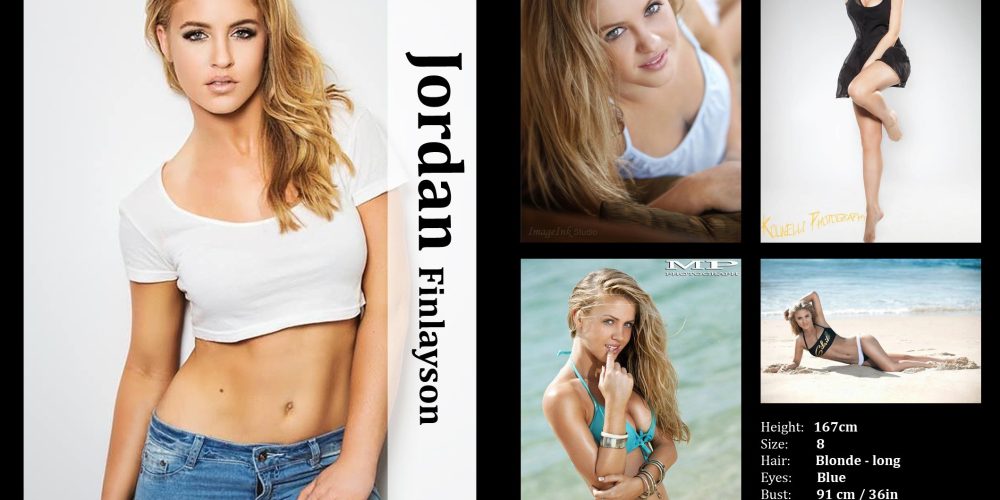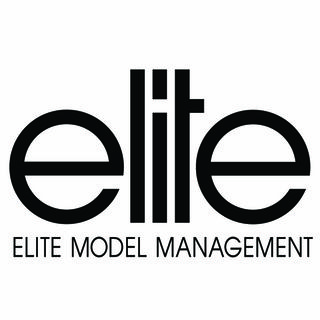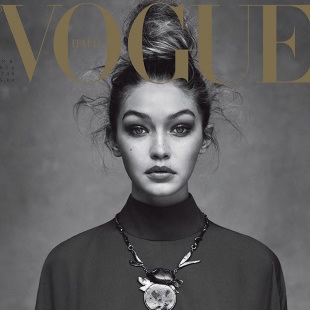A composite card (“comp card”) is a cardboard card with a collection of pictures and information about you and your agency (if you do not have an agency, the card lists your contact information). It is sent by agents and models to potential clients as a way of letting them know about the model, and you leave one at go-sees so they can remember you. Composite cards may have as little as one picture or as many as a dozen or more spread over three pages. The most typical comps are 5 ½ x 8 ½ inches in size, printed on heavy card stock, double sided. They contain a good head shot on one side, three or four other pictures on the reverse, and your measurements and agency or personal contact data. Pictures should be mostly color, but some good-quality B&W shots can be acceptable on comps. When you lay out the card, you should make it so it can be used by an agency when you get one. The agency will want to put their logo or sticker (typically ¾”x2 ½”) on the card, and will cover any contact data you have on it. Here is a “standard” layout of the front and back of a card:
FrontBack
Notice the space left on the card for the model to put her contact information, or for an agency to place their sticker. The pictures on your card need to reflect your current appearance. If you make a significant change (cut your hair much
shorter or color it, gain or lose a lot of weight) you need a new card.
Who Chooses the Shots?
The best person to choose the shots on a card is your agent. He is getting paid for his special expertise in marketing you, and in knowing what pictures will do that best. If you have an agent, use him. The worst person to choose the pictures is your mother or father (unless one of them works at an advertising agency). Inevitably parents have an idealized vision of what their child looks like, or what they want to see them look like, and they will pick pictures that are close to that vision. It may have nothing to do with the way you need to be presented to the market. You shouldn’t pick the shots either, for reasons similar to why your
parents shouldn’t. If you don’t have an agent, you need to find a friend who
works in the advertising, publishing or modeling industry – someone who sees advertising or fashion pictures on a regular basis and knows what they look like. They should be currently working in the field. Styles change, and people with 15-year old experience may have very different views from what the market actually wants.
Getting It Printed
Once you have good quality pictures your agency can assist you in finding printers. If you don’t have an agency you will have to do it for yourself. In most cities with a reasonable amount of modeling work there are printing companies that specialize in comp cards and can do them easily and quickly for you. You simply need to bring in your pictures and stats, and they will help you select a pre-made format. If you cannot find such a printer in your area, you may have the layout work done separately and then give it to the printer. Composite cards should be updated as you get better pictures or tearsheets, so it isn’t usually necessary to
print more than 50-150, depending on how many agencies you have and how much you and they need for marketing. There are companies on the Internet that specialize in
printing comp cards, and offer low prices. Some of them do very good work, but many do not use good enough stock. Be sure to get a sample before you order from such a company, and ensure that the card is sufficiently heavy, and the printing crisp and
clear. Flimsy cards or muddy pictures will not help you look professional.
Laser or Offset?
There are two common kinds of mass color printing: laser prints and offset. Both are acceptable, although offset printing on good coated stock gives a smoother, more flattering and professional look to the card. Offset printing involves a setup
cost, so only runs of 100 or more cards are cost-effective. Laser cards do not require expensive plates to be made, and they can be economically produced in lower quantity.
Cost of Printing
Local print shops should be able to do a run of 100 color, twosided comp cards for anywhere from $100 to $175 including layout and setup. Some print shops on the Internet are cheaper; in small cities where few comp cards are printed, it may be more expensive.
Self Printing
These days good inkjet printers can produce pictures every bit as good as an offset or laser printed card. Many models are tempted to print their own comp cards. You can do that, but you should consider the following:
1. Format. People laying out their own cards tend to produce cards with fancy, distinctive graphics, strange fonts and non-standard layouts. That is almost always a bad idea. Get some agency cards to use as examples, and produce a card similar to the simplest of what you find.
2. Card Stock: The biggest failing of self-printed cards is that they are printed on flimsy paper, sometimes two pieces of paper glued together. These look cheap and cheesy; the message being sent is that you aren’t sufficiently committed to your craft to invest in professional printing. Clients take those messages to heart. Another pitfall models fall into is printing on glossy stock. Professionally printed comp cards are on a matte surface, not glossy.
3. Picture Placement: There are composition rules which agencies and good print shops know to tell you how to place your pictures. If you don’t know those things, get professional advice before making your card.
Promotional Models
Promotional Models often do not need a composite card. It is common to use something like an actor’s headshot: an 8×10 glossy.
Other Reasons for Shooting
If you are like most models you like to shoot, and you like the pictures you get from shooting. Even if there is no likelihood that a shoot will result in pictures you can use to market yourself, shooting still may be a good idea. Models need practice in front of a camera; they may want pictures very different from their
“professional” shots just for the enjoyment of creating them; they may want to network with photographers in the hope of being remembered when a real, professional job comes along.
You can choose photographers much differently than you would for a “portfolio” shoot. If possible you want to work with photographers that are at or above your level of experience, and to work with increasingly skilled photographers as you progress in your career. You can learn something from almost any photo shoot, but your chances of learning a lot, of getting pictures you really like, or of getting later benefits such as jobs or referrals are greatly improved if you choose high quality photographers. It’s easy to waste time with “photographers” who just don’t get it and
never will — and they tend to find you. Resist the temptation. Always review the work of the photographers you are considering, and make sure that you would like pictures of yourself shot in their style before booking the shoot.

Model Safety
03.06.2023
Internet modeling by its very nature is much less safe than mainstream. Many of the clients whether for paid or TFP shoots) are not professi

CHRISSY TEIGEN, THE COMMERCIAL SUCCESS STORY
04.06.2022
With a majorly popular (and sometimes controversial) twitter presence, Sports Illustrated model Chrissy Teigen is having a moment. Cosmopoli





Comments 0